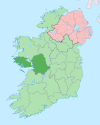
Connemara is a region on the Atlantic coast of western County Galway, in the west of Ireland. The area has a strong association with traditional Irish culture and contains much of the Connacht Irish-speaking Gaeltacht, which is a key part of the identity of the region and is the largest Gaeltacht in the country. Historically, Connemara was part of the territory of Iar Connacht. Geographically, it has many mountains, peninsulas, coves, islands and small lakes. Connemara National Park is in the northwest. It is mostly rural and its largest settlement is Clifden.

Clifden is a coastal town in County Galway, Ireland, in the region of Connemara, located on the Owenglin River where it flows into Clifden Bay. As the largest town in the region, it is often referred to as "the Capital of Connemara". Frequented by tourists, Clifden is linked to Galway city by the N59.

Ballynahinch or Ballinahinch is a village in County Galway in the west of Ireland. It is situated close to Recess, on the road from Recess to Roundstone. It also lies on the route of the former railway line from Galway city to Clifden. The name comes from the Irish Baile na hInse meaning settlement of the island.
The Conmhaícne Mara or Conmaicne Mara were an early people of Ireland. Their tuath was located in the extreme west of County Galway, Republic of Ireland, giving their name to Connemara, an anglicised form of Conmhaicne Mara.
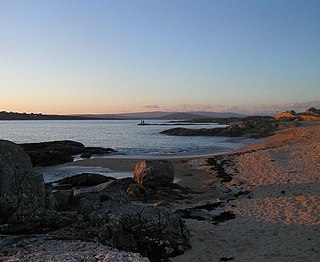
Carraroe is a village in Connemara, the coastal Irish-speaking region (Gaeltacht) of County Galway, Ireland. It is known for its traditional fishing boats, the Galway Hookers. Its population is widely dispersed over the Carraroe peninsula between Cuan an Fhir Mhóir and Cuan Chasla. Carraroe has an unusual beach, Trá an Dóilín, a biogenic gravel beach made of coralline algae known as "maerl".

The Connemara pony is a pony breed originating in Ireland. They are known for their athleticism, versatility and good disposition. The breed makes excellent show ponies.

Letterfrack or Letterfrac is a small village in the Connemara area of County Galway, Ireland. It was founded by Quakers in the mid-19th century. The village is south-east of Renvyle peninsula and 15 kilometres north-east of Clifden on Barnaderg Bay and lies at the head of Ballinakill harbour. Letterfrack contains the visitors centre for Connemara National Park.
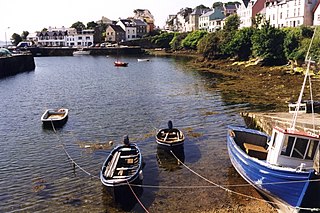
Roundstone is a village on the west coast of Ireland, in the Connemara region of County Galway. Lying opposite the island of Inishnee on Roundstone Bay, by road it is 76 kilometres (47 mi) northwest of Galway and 18 kilometres (11 mi) southeast of Clifden. Known as a haven for people in the creative arts, it hosts an annual regatta in July.

Barna is a coastal village on the R336 regional road in Connemara, County Galway, Ireland. It has become a satellite village of Galway City. The village is Irish speaking and is therefore a constituent part of the regions of Ireland that make up the Gaeltacht.

Furbo or Furbogh is a settlement in Connemara, County Galway, Ireland. As of the 2022 census, it had a population of 868 people. It lies along the coast, overlooking Galway Bay, in a Gaeltacht area.
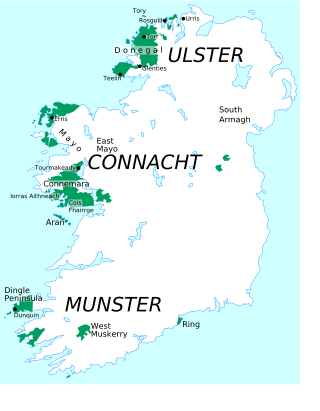
Connacht Irish is the dialect of the Irish language spoken in the province of Connacht. Gaeltacht regions in Connacht are found in Counties Mayo and Galway. Connacht Irish is also spoken in the Meath Gealtacht Ráth Chairn and Baile Ghib. The dialects of Irish in Connacht are extremely diverse, with the pronunciation, forms and lexicon being different even within each county.

Claddaghduff is a village in County Galway, Ireland. It is located northwest of Clifden, the gateway to Omey Island.
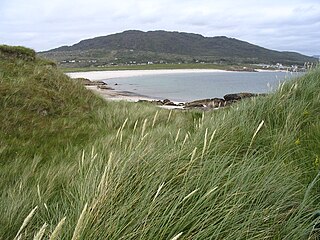
Errisbeg Mountain or Errisbeg is a hill in Roundstone, County Galway, in the West of Ireland, with a height of 300 m.
Conneely, from or, is an Irish family name. Frequent examples of the name can be found in the West of Ireland, particularly in the Connemara area of County Galway. A coastal village in County Galway is named Ballyconneely.
Alexander Nimmo FRSE MRIA MICE HFGS was a Scottish civil engineer and geologist active in early 19th-century Ireland.

Ó Conghalaigh is a Gaelic-Irish surname. It derives from the forename Conghal, meaning "fierce as a hound". It is often anglicised as Connolly, Connally, Connelly and occasionally as Conley. In modern Irish it may be spelled as Ó Conghaile.

Toombeola is a townland in the historical barony of Ballynahinch in Connemara, County Galway, Ireland. It is located near the Atlantic Coast, 44 miles (71 km) west of Galway City, 4 miles (6.4 km) east of Roundstone, and 10 miles (16 km) south east of Clifden. As of the 2011 census, Toombeola townland had a population of 18 people.

Renvyle or Rinvyle is a peninsula and electoral division in northwest Connemara in County Galway, close to the border with County Mayo in Ireland.

Maumeen Lough is a freshwater lake in the west of Ireland. It is located in the Connemara area of County Galway.

The R341 road is a regional road in Ireland. It is a loop road from the N59 road in County Galway. South of the R342, the road is part of the Wild Atlantic Way.



















